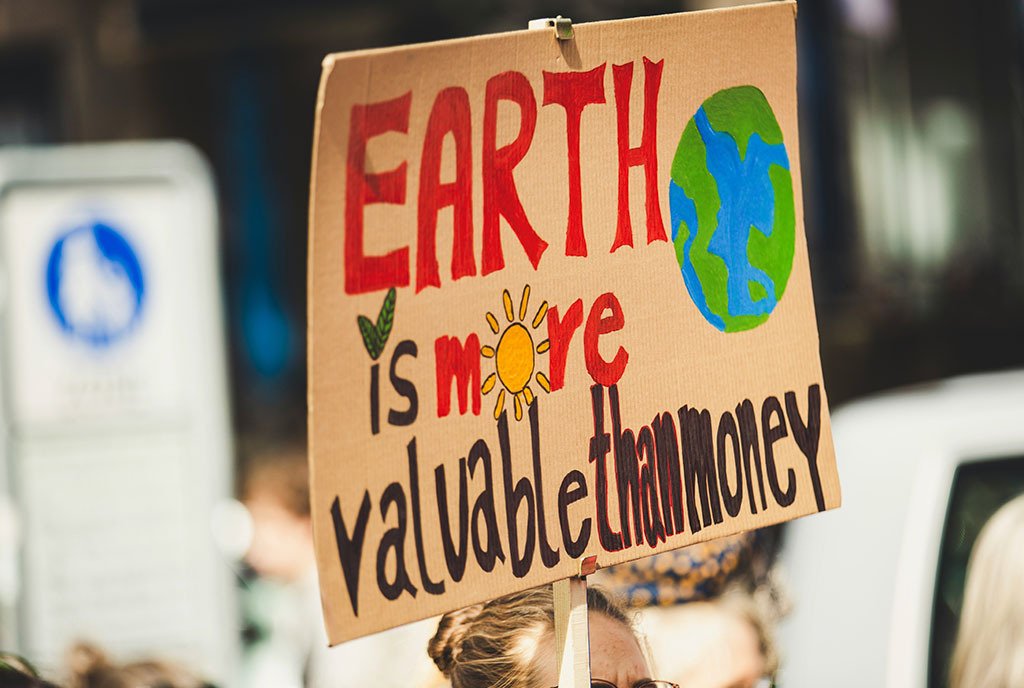
We’re going green may be the subject of an email you’ve received recently. From utilities to social services, organizations of all sorts and sizes are making the move from paper to digital, if they haven’t already. And companies are being more transparent about their carbon footprints, with some prompting financial contributions to offset the amount of greenhouse gases generated by conducting business, whether that business is shipping an item or flying across the country.
According to State of the Planet from the Columbia Climate School, people have come to expect environmental transparency: “Consumers are driving companies to be more transparent by patronizing more eco-conscious brands.”
For more and more donors, how a nonprofit treats the Earth is becoming a priority.
This shift toward eco-conscious businesses comes even as over-consumerism—one of the actions contributing to climate change—shows no sign of stopping. As NPQ wrote in 2023, “The purchasing choices of an individual can help. Rampant consumerism and mounting trash and plastic waste are contributing factors to the changing climate. What you buy—or more importantly, don’t buy—can help mitigate some of the impacts of climate change.”
But how does the push for sustainability impact nonprofits? How can organizations whose donors care about the planet switch to green without falling into the trap of greenwashing (or promoting false impressions of environmental friendliness)? And what is all this going to cost?
Growing Public Concerns
While the list of nonprofits and grassroots groups focused on climate justice is long—and in our era of extreme weather events, ever-growing—organizations without a mission centering on the environment may not be as concerned with sustainability. For most nonprofits, sustainability refers to the self-sufficiency and financial independence of initiatives. But for more and more donors, how a nonprofit treats the Earth is becoming a priority.
As Philanthropy News Digest wrote in 2009, “Adopting green practices shows that you appreciate the value of a healthy environment, are paying attention to public concerns about the environment, and are willing to make changes in response to those concerns.” In other words, you are listening to an outcry that has only grown louder.
Charity Digital called this “the rise of the eco-friendly donor,” citing research that for 66 percent of those surveyed, sustainability was one of their top five concerns when making a purchase. Over 30 percent of respondents were willing to pay more for a product or service that was environmentally friendly.
When it comes to charitable organizations, according to other research, 24 percent of members were asked by individual donors and 25 percent by funders if an organization was environmentally sustainable. As Charity Digital wrote, “The public are rightly concerned about the climate and that means your charity needs to be too. We have a collective responsibility to take climate action.”
The nonprofit industry is responsible for 10 percent of all mail volume in the United States.
Actions and Their Costs
What are some of the actions that nonprofits can take, particularly those organizations with no specific mission related to the environment?
Sign up for our free newsletters
Subscribe to NPQ's newsletters to have our top stories delivered directly to your inbox.
By signing up, you agree to our privacy policy and terms of use, and to receive messages from NPQ and our partners.
Starting small can still make an impact. Doing away with business cards, for example, can drastically reduce paper waste. Forbes described paper business cards as a relic of the past: easily lost, discarded, or forgotten, while virtual business cards, such as a short video linked online, “can provide richer information.” One expert interviewed by Forbes said, “Gone are the days of searching for someone’s business card you met at a conference six months ago. All you need is a name, company and LinkedIn to revisit a connection. LinkedIn is your digital Rolodex.”
Reducing paper waste, in general, can be important for an organization, starting as simple as printing pages on both sides or doing away with hard copies. Unnecessary paper usage is a drain on resources that adds up. Paper is often forgotten in printers—which themselves deplete the environment, as a cheap technology that is dated and discarded quickly—or printed by mistake. One institution, the College of New Jersey, estimated that 25 percent of its pages printed yearly “perhaps as much as 1.25 million pages per year—end up in the recycle bin.”
When it comes to paper mail, much of what we receive is recycled—or worse, trashed. The Sierra Club has called banning junk mail “a modest environmental reform that would require little investment but would help avoid millions of tons of greenhouse gas emissions a year and protect wildlife.”
While committing to a greener way of operating is not without potential financial cost, nonprofits ignore the climate at their peril.
According to the Alliance of Nonprofit Mailers, the nonprofit industry is responsible for 10 percent of all mail volume in the United States. Direct mailing is still a popular tool for many nonprofits. To do away with paper mail entirely could mean nonprofits miss reaching established donors. However, the point has been made for decades: “sending mass mailings to strangers is a less and less effective way for grassroots organizations to find new donors.”
Going Green Online
Moving to an online donation system, rather than accepting or encouraging paper checks, is another green move. “During the COVID-19 pandemic, online fundraising has saved many nonprofits from closing,” according to DonorBox. The organization argued that digital fundraising would only “continue to grow as technology advances,” citing research that fundraising online increased by 21 percent in 2020.
COVID also prompted many nonprofits, organizations, and businesses around the world to shift to remote work. Working from home not only cuts down on the energy usage of office buildings and commuting, parking, or transportation costs and emissions; but virtual work is also more equitable, providing greater employment opportunities for people with accessibility needs and those with families or geographic considerations. People who support nonprofits also continue to expect online programming like webinars versus in-person seminars and may look for those in the field to choose virtual conferences when possible rather than flying.
Consumers and donors alike are becoming savvy about the tactics of greenwashing, which CNN defined as “disinformation [disguised] as environmentalism to market a corporation’s products or improve its public reputation.” But participating in just causes may be the cure. CNN recommended “getting connected to local grassroots environmental justice groups” in order to become involved in—and informed about—the work being done locally to combat climate change.
While committing to a greener way of operating is not without potential financial cost, nonprofits ignore the climate at their peril. Supporters of social justice causes are looking for organizations to consider the environment more and more.
As Philanthropy News Digest wrote, “Nonprofits exist for the benefit of the public, and giving back—to our communities, to our employees and volunteers, to the environment—bolsters and reinforces our value to society.”












